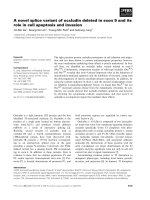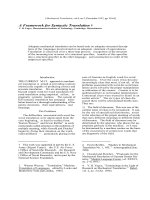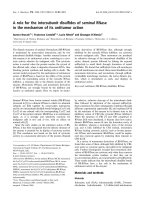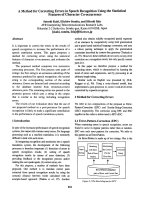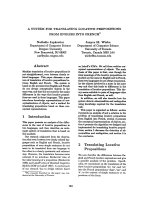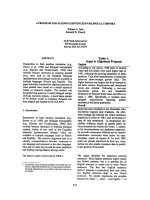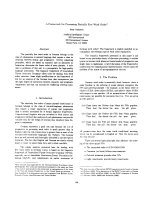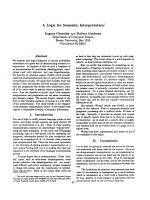Báo cáo khoa học: "A Method for Relating Multiple Newspaper Articles by Using Graphs, and Its Application to Webcasting" pptx
Bạn đang xem bản rút gọn của tài liệu. Xem và tải ngay bản đầy đủ của tài liệu tại đây (616.62 KB, 7 trang )
A Method for Relating Multiple Newspaper Articles by Using
Graphs, and Its Application to Webcasting
Naohiko Uramoto and Koichi Takeda
IBM Research, Tokyo Research Laboratory
1623-14 Shimo-tsuruma, Yamato-shi, Kanagawa-ken 242 Japan
{ uramoto, takeda } @trl. ibm. co.j p
Abstract
This paper describes methods for relating (thread-
ing) multiple newspaper articles, and for visualizing
various characteristics of them by using a directed
graph. A set of articles is represented by a set of
word vectors, and the similarity between the vec-
tors is then calculated. The graph is constructed
from the similarity matrix. By applying some con-
straints on the chronological ordering of articles, an
efficient threading algorithm that runs in O(n) time
(where n is the number of articles) is obtained. The
constructed graph is visualized with words that rep-
resent the topics of the threads, and words that rep-
resent new information in each article. The thread-
ing technique is suitable for Webcasting (push) ap-
plications. A threading server determines relation-
ships among articles from various news sources, and
creates files containing their threading information.
This information is represented in eXtended Markup
Language (XML), and can be visualized on most
Web browsers. The XML-based representation and
a current prototype are described in this paper.
1 Introduction
The vast quantity of information available today
makes it difficult to search for and understand the
information that we want. If there are many related
documents about a topic, it is important to capture
their relationships so that we can obtain a clearer
overview. However, most information resources, in-
cluding newspaper articles do not have explicit re-
lationships. For example, although documents on
the Web are connected by hyperlinks, relationships
cannot be specified.
Webcasting ("push") applications such as Point-
cast i constitute a promising solution to the prob-
lem of information overloading, but the articles they
provide do not have links, or else must be manually
linked at a high cost in terms of time and effort.
This paper describes methods for relating news-
paper articles automatically, and its application for
a Webcasting application. A set of article on a par-
I htt p://www.pointcast.com
ticular topic is ordered chronologically, and the re-
sults are represented as a directed graph. There are
various ways of relating documents and visualizing
their structure. For example, USENET articles can
be accessed by means of newsreader software. In the
system, a label (title) is attached to each posted mes-
sage, specifying whether it deals with a new topic or
is a reply to a previous message. A chain of articles
on a topic is called a thread. In this case, the rela-
tionships between the articles are explicitly defined.
This post/reply-based approach makes it possible for
a reader to group all the messages on a particular
topic. However, it is difficult to capture the story of
the thread from its thread structure, since appropri-
ate titles are not added to the messages.
This paper aims to provide ways of relating mul-
tiple news articles and representing their structure
in a way that is easy to understand and computa-
tionally inexpensive. A set of relationships is defined
here as a directed graph. A node indicates an arti-
cle, and an arc from node X to Y indicates that the
article X is followed by Y (or that X is adjacent to
Y). An article contains both known and unknown
(new) information. Known information consists of
words shared by the beginning and ending points of
an arc. When node X is adjacent to Y, the words
are represented by (X fq Y). The known information
is called genus words in this paper. Even if an article
follows another one, it generally contains some new
information. This information can be represented
by subtraction (Y- X) (Damashek, 1995), and is
called differentia words, by analogy with definition
sentences in dictionaries, which contain genus words
and differentia. In this paper, genus and differentiae
words are used to calculate the similarities between
two articles, and to visualize topics in a set of arti-
cles.
Since articles are ordered chronologically, there
are some time constraints on the connectivity of
nodes. A graph is created by constructing an ad-
jacency matrix for nodes, which in turn is created
from a similarity matrix for nodes.
Some potential features of articles in a set can be
determined by analyzing some formal aspects of the
1307
d2 d3
od5 .od6
Figure 1: Example of a Directed Graph G
corresponding graph. For example, the paths in the
graph show the stories of the nodes they contain.
Multiple paths for a node (article) show that there
are multiple stories associated with it. Furthermore,
if the node has a long path, it is in the "main stream"
of the topic represented by the graph. An efficient
algorithm for finding such paths is described, later
in the paper.
Application of the threading method to docu-
ments on the Web would be very useful because, al-
though such documents are connected by hyperlinks,
their relationships cannot be specified. In this paper,
generated threads by this method are represented in
eXtended Markup Language (XML) (XML, 1997),
which is the proposed standard for exchange of in-
formation on the Web. XML-based threads can be
used by webcasting or push services, since various
tools for parsing and visualizing threads are avail-
able.
In Section 2, a directed graph structure for arti-
cles is defined, and the procedure for constructing a
directed graph is described in Section 3. In Section
4, some features of the created graph are discussed.
Section 5 introduces a webcasting application by us-
ing the threading technique, and Section 6 concludes
the paper.
2 Definition of a Graph Structure
A set of articles is represented as an ordered set V:
V = {dx,d2, ,d,}.
The suffix sequence 1, 2, , n represents the pas-
sage of time. Article
di
is older than
di+l.
The order
is obtained from the publication dates of the articles.
Different time points arbitrarily are assigned to ar-
ticles published on the same day.
Related articles are represented as a directed
graph
(V,A). V
is a set of nodes. A is a set of
ordered pairs
(i, j),
where i and j are members of
V. Figure 1 shows an example of a directed graph.
In this case, the graph is represented as follows:
V = {dl,d2,d3,d4,ds,d6,d6,d7},
A = {(dl,d2),
(d2, d3), (dl, d4), (d5, d6), (d2, dT), (d3, ds), (dT, ds)}
The nodes are ordered chronologically. The fol-
lowing constraint is introduced into the graph:
M =
dl
d2
d3
d4
45
d6
d7
ds
dx d2 d3 d4 d5 d6 d7 ds
0 1 0 1 0 0 0 0
0 0 1 0 0 0 1 0
0 0 0 0 0 0 0 1
0 0 0 0 0 0 0 0
0 0 0 0 0 1 0 0
0 0 0 0 0 0 0 0
0 0 0 0 0 0 0 1
0 0 0 0 0 0 0 0
Figure 3: Adjacency Matrix Mc of G
Constraint 1
For (di,dj) 6 A, i < j
The constraint simply shows that an old article
cannot follow a new one.
3 Creating a Graph Structure for
Articles
This section describes how to construct a directed
graph structure from a set of articles. Any directed
graph can be represented by a matrix. Figure 3
shows the adjacency matrix
MG
of the graph G in
Figure 1.
For example, a value of "1" for the (1, 2) element
in M indicates that dx is adjacent to d2. Since an
article cannot follow itself, the value of (i, i) elements
is "0". From the time constraint defined in Section
3, MG
is an upper triangle matrix.
The following is a procedure for constructing a
directed graph for related articles:
1. Calculate the similarity and difference between
articles.
2. Construct a similarity matrix.
3. Convert the matrix into an adjacency matrix.
In the next section, each step is illustrated by us-
ing the set of articles V in Figure 2 on the subject
of nuclear testing taken from the Nikkei Shinbun. 2
3.1 Calculating the similarities and
differences between articles
The function
sim(di,dj)
calculates the word-based
similarity between two articles. It is defined on the
basis of Salton's Vector Space Model (Salton, 1968).
Words are extracted from an article by using a mor-
phological analyzer. Next, nouns and verbs are ex-
tracted as keywords.
_ di wdi
sim(di,dj) = ~-,k,,, wkw k~
kWkw) k kw]
2The articles were
originally written in
Japanese.
1308
dl: The prime minister of France says that it is necessary to restart nuclear testing.
d2: The Defense Minister suggests restarting nuclear testing.
d3: At a summit conference, the Prime Minister will adopt a policy of requesting the French Government to
halt nuclear testing.
d4: China's latest nuclear test will hold up negotiations on a treaty to abolish such testing.
d5: The Minister of Foreign Affairs, Mr. Youhei Kohno, takes a critical attitude toward China, and asks
France to understand Japan's position.
d6: The prime minister of New Zealand asks the French Government not to restart nuclear testing.
dT: President of France states that nuclear testing will restart in September, and that France will conduct
eight tests between now and next May.
d8:
France states that it will restart nuclear testing. This will hamper nuclear disarmament.
dg: France states that it will restart nuclear testing. Australia halts defense cooperation with France.
dlo: France states that it will restart nuclear testing. The U.S. expresses regret at the decision.
Figure 2: V: Articles about nuclear testing
Here, di is the weight given to the keyword
Wkw
kw
in article
di.
Modification of the TF.IDF
value (Robertson
et al.,
1976) is used for the weight-
ing.
9d,
is the weight assigned to the keyword
kw,
kw
which is a differentia word for
di.
Cdl (kw) k dl
= . u -(kwl . g w,
d,
r 1.5
kw E differentia(di)
gkw = ~ 1 otherwise.
Other parameters are defined as follows:
k: constant value
Cd,(kw):
frequency of word
kw
in
d(i)
Cd,
: number of words in
d(i)
Nk(kw):
number of articles that contain the word
kw
in k articles
di-k, ,di
The function
differentia(d{)
returns a set of key-
words that appear in
dj
but do not appear in the
last k articles.
di.fferentia(di) = {kw[Cd,(kw)
> 0, and for all
dt,
where i - k < l < i, Cd,(kw) = O}
3.2 Constructing a similarity matrix
A similarity matrix for a set of articles is constructed
by using the
sim
function. In a conventional hierar-
chical clustering algorithm, a similarity for any com-
bination of two articles is required in order to con-
struct a hierarchical tree of the set of articles. This
causes ~ calculations of the similarity func-
tion, for n articles, with a consequent complexity
of
O(n2).
This is very expensive when n is large.
In our algorithm for constructing a similarity ma-
trix, shown in Figure 4, the complexity of construct-
ing a graph structure for an article set by using a
constraint is
O(n).
The following constraint, which
procedure MakeDistanceMatrix
for i= 2 to n begin
if i-k< 1 thens+- 1 elses+ i-k
forj =stoi-lbegin
a(i,j) +- sim(di,dj)
j~-j+l
end
i+-i+l
end
Figure 4: Procedure for Constructing Similarity Ma-
trix
includes Constraint 1, is used for in threading algo-
rithm.
Constraint 2
For (di,dj) E A, j - (k + l)
<i<j
This constraint means that an article can only fol-
low the last k articles. As the result, the number of
times the similarity matrix needs to be calculated is
reduced by
kn,
giving a complexity of
O(n).
By using the algorithm, each similarity between
nodes is calculated, and the similarity matrix in Fig-
ure 5 shows a similarity matrix S of V. In this case,
keywords are extracted from title sentences, and k
is set to five.
3.3 Conversion into an adjacency matrix
From the similarity matrix, an adjacency matrix is
constructed. An element
s(i, j)
in the similarity ma-
trix corresponds to the element
ss(i,j)
in the adja-
cency matrix SS. There are various strategies for the
conversion. In this paper,
ss(i,j)
is set to 1 when
s(i, j) > 0.18, and any node can follow at most k/2
nodes, in this case two nodes. Figure 6 shows a re-
sult of the conversion. Finally, a directed graph for
V is created (Figure 7). Figure 8 shows a graph that
visualizes the content of the articles in our example.
1309
S =
dl
d2
d3
d4
ds
d~
d7
d8
d9
dlo
dl d2 d3 d4 d5 d6 d7 ds d9 dio
0 .309 .239 .072 .131 .319 0 0 0 0
0 0 .159 .072 .131 .319 .197 0 0 0
0 0 0 .056 .103 .498 .103 .124 0 0
0 0 0 0 .186 .056 .046 .056 .046 0
0 0 0 0 0 .102 .085 .102 .128 .096
0 0 0 0 0 0 .154 .176 .206 .209
0 0 0 0 0 0 0 .308 .320 .323
0 0 0 0 0 0 0 0 .257 .279
0 0 0 0 0 0 0 0 0 .287
0 0 0 0 0 0 0 0 0 0
Figure 5: Similarity Matrix S
dl
d~
d3
d4
ds
d6
d7
ds
d9
dlo
dl d2 ds d4 ds d6 d7 ds d9 d,o
0 1 1 0 0 0 0 0 0 0
0 0 0 0 0 1 1 0 0 0
0 0 0 0 0 I 0 0 0 0
0 0 0 0 I 0 0 0 0 0
0 0 0 0 0 0 0 0 0 0
0 0 0 0 0 0 0 0 0 0
0 0 0 0 0 0 0 1 1 1
0 0 0 0 0 0 0 0 1 0
0 0 0 0 0 0 0 0 0 I
0 0 0 0 0 0 0 0 0 0
d2
dl
d4
o
,C s
d8
d9
dlO
Figure 7: Directed Graph G1 for V
Figure 6: Adjacency Matrix SS Converted from S
There are two threads in the graph. One concerns
for France's restarting of nuclear testing. The other
concerns China's latest nuclear test. The "France"
thread contains two sub-threads. One concern re-
quests by other countries for France to reconsider its
stated intension of restarting nuclear testing, and the
other concerns responses by other countries to the
France government's official statement on testing.
Some articles are followed by multiple articles. For
example, d7 is the first official statement on France's
restarting of nuclear testing, and many related arti-
cles on this topic follow.
Each rectangle in Figure 8 represents an article.
Words in a rectangle are differentia words for the
articles. These words show new information in the
article, and make it easy to understand the content
of the articles. If a word in an article appears in
the differentia words for its parent article, the word
may represent a "turning point" in the story of the
articles. For example, the word "state" is the dif-
ferentia word for dT, and is in its adjacent articles
ds, dg, anddlo. This means that d7 is a starting point
of the new topic "state." Such words are called topic
words, and are represented in Figure 8 by bold type.
Several features of the graph visualize the charac-
teristics and relationships of the articles: these fea-
tures will be discussed in the next section.
It is difficult to evaluate the result of threading.
We are implementing it in a webcasting (push) ap-
plication so that it can be evaluated by the many
people who use ordinary web browsers. The attempt
is described in Section 5.
4 Features of a Graph
This section describes how the features of a con-
structed graph represent the characteristics of arti-
cles.
4.1 In-degree and Out-degree
The in-degree is the number of arcs leading to a node,
while the out-degree is the number of arcs leading
from it. The in-degree of di can be calculated by
adding up the elements in the i-th column of an adja-
cency matrix. The out-degree of di can be calculated
by adding up the elements in the i-th row of the ma-
trix (Figure 9). In Botafogo et al. (Botafogo et al.,
1992), a node that has a high out-degree is called an
index node, while a node that has a high in-degree is
called a reference node in their analysis of hypertext.
In the set of articles V shown in Figure 9, d7 is an
index node. In this paper, an index node denotes the
beginning of a new topic. When the topic is impor-
tant, many articles follow, and consequently the out-
1310
dl
France restart
nuclear testing
d4
China
latest
hold-up
negotiation
treaty
d3 d6
halt Summit
request
France ~ New Zealand
restart
nuc,ear
l/ _Isuggest [/
~Defence Ministe~
~dd/r
d8
esident state [state ,[ hamper
conduct~ 1
[September
[
disarmament
\ \ d9
\ ~ Australia
\ ] defence
[
cooperation
China
, Mr. Yohei Kohno ~ ~U.S. express
attitude understand ~ regret decision
Japan position
Figure 8: Visualized Content for G1
dl d2 d3 d4 d5 d6 d7 d8 d9 dl0
in 0 1 1 0 1 2 1 1 2 2
out 2 2 1 1 0 0 3 1 1 0
Figure 9: In-degree/Out-degree of the Graph G1
degree for the node increases. The contribution of
reference nodes is not clear in V (d6, ds, and d9 have
max in-degrees). Nodes that have high in-degree
have two characteristics. The first is that when the
articles contain multiple topics, they have many in-
bound arcs, each representing a different topic. The
second is that when the articles are closely related
for a particular topic, the in-degrees of related nodes
increase, since these articles are connected to each
other.
4.2 Path
A path from one node to another node shows the
"story flow" of articles. Multiple paths between
two nodes show different stories about the nodes.
For example, there are three paths between dl,
which is a first node, and dl0. The shortest path
(dl, d2,, dT, dl0) gives a simple outline of the articles.
The longest path (d,, d2, d7,
ds,
dg, dl0) contains all
related information on the topic. By extracting long
paths from the graph and combining them, various
stories can be created.
The length of a path shows how the nodes on it
[ along to the "main stream" of the story. For ex-
mple, the maximum length of a path through
d6,
is
three, while that of a path through d7 is five. This
means that a path that contains d7 is on a main
stream of the thread and is likely to be continued.
The longest paths for nodes can be calculated by
using the algorithm shown in Figure 11. Its com-
plexity is
O(n),
since the maximum number of arcs
is at most
nk
for n nodes, from Constraint 2, defined
in Section 3.2.
4.3 Cycle
A cycle 3 shows the existence of a topic. In V,
{dT,
ds, dg,
dl0} is a cycle for the topic "statement."
By recognizing cycles, we can extract topics from the
whole graph. Furthermore, we can abstract articles
by reducing cycles to single nodes.
5 XML-based Representation for
Threads
It is important that the threading information be ex-
changeable when we apply our method to Web docu-
ments. Extended Markup Language (XML) is a pro-
posed standard (XML, 1997) specified by the World
Wide Web Consortium (W3C). In XML, tags and
3Formally, it is called a semi-cycle, since the graph is di-
rected.
1311
attributes can be defined, whereas in HTML they
are fixed. XML documents can be used to exchange
information that has various data structure. For
example, Channel Definition Format (CDF)(CDF,
1997) is a standard to offer frequently updated col-
lections of information (channels) on Web. A CDF
document can contains a collection of articles that
have tree structure. In this paper, graph structures
of created threads are represented in XML. Figure 10
shows a part of the thread in Figure 8.
The <thread> tag shows the beginning of the
thread. It contains a set of deceptions for arti-
cles, each marked <article>. Each instance of
the <article> tag has a reference to its source
document, an identifying id, genus and differentia
words, and other information on the article. The
tag <follows> is used to denote arcs from the ar-
ticle to related articles.
The XML documents can be separate from the
source articles. They can be provided as part of a
"push" service for Internet users, offering a solution
to the problem of information overloading. In such
a service, gatherer collects articles from Web sites
and threader makes threads for them. The results
are stored in XML, and then pushed to subscribers
who can capture the flow of topics by following the
threads. In another scenario, when a user gets an
article, and wants to see its origin or the next re-
lated article, he or she gets the thread containing
the article by consulting the threading server. The
advantage of using XML is that it will be supported
by various tools, including Web browsers. Now we
are prototyping the threading service system by us-
ing a XML processor developed at our laboratory.
Figure 12 shows a Java applet for viewing threads,
which can run on major Web browsers. A XML doc-
ument is parsed and visualized as tree-like structure.
6 Related Work
There have been several studies how to relate arti-
cles (McKeown et al., 1995; Yamamoto et al., 1995;
Mani et al., 1997). McKeown et al. reported a
method for summarizing news articles (McKeown
et al., 1995). In their approach, templates, which
have slots and their values (for example, incident-
location="New York"), are extracted from the ar-
ticles. Summary sentences are constructed by com-
bining the templates. Although this approach can
capture topics contained in the articles, the relation-
ships between articles are not visualized.
Clustering techniques make it possible to visual-
ize the contents of a set of documents. Hearst et
al. proposed the scatter/gather approach for facil-
itating information retrieval (Hearst et al., 1995).
Maarek et al. related documents by using an hier-
archical clustering algorithm that interacts with the
user. Although these clustering algorithms impose a
procedure
GetMaxtPath(A)
//Get max path MaxPath[i] for di. A is a set of arcs.
for
i = 1 to n begin MaxPath[i] +- NULL
end
for
j = 1 to n begin
fori=j-ktoj-
lbegin
if (di, dj) E A then
if Length(MaxPath[j]) < Length(MaxPath[i]) + 1
then
MaxPath[j] e Connect(MaxPath[i],(di,dj))
i+ i+ 1
end
j+-j+l
end
procedure
Length(path)
returns the number of arcs in path.
procedure
Connect(path, arc)
if path = (do, , di) and arc = (di, dj), then
return (do, , di, dj).
Figure 11: Procedure for Finding the Longest Path
heavy computation cost, our threading algorithm is
efficient, because it uses a chronological constraint.
7 Conclusion
We have described methods for threading multiple
articles and for visualizing various characteristics of
them by using directed graphs. An efficient thread-
ing algorithm whose complexity is O(n) (where n is
the number of articles) was introduced with some
constraints on the chronological ordering of articles.
Some further work can be done to improve our
method. There are sonie strategies for constructing
an adjacency matrix from a distance matrix. Differ-
ent strategies give different graphs. We are now eval-
uating our method by testing it with various strate-
gies.
The development of a technique for visualizing di-
rected graphs is another task for the future. Al-
though directed graphs show more useful informa-
tion than tree structures, they are difficult to display
in a readily understandable way. Software tools for
handling graphs are also required.
Formal features of graphs can express the under-
lying characteristics of articles. More efficient and
useful algorithms are needed to overcome the prob-
lem of information overload.
References
R. Botafogo, E. Rivlin, and B Shnederman. 1992.
Structural Analysis of Hypertexts: Identifying Hi-
erarchies and Useful Metrics. A CM Transaction
on Information Science, pages 143-179, Vol. 10,
No. 2.
C. Ellerman. 1997.
1312
<thread id="threadl">
<article id="dl"
HKEF="foo.bar.com/article/dl.html">
<title>The prime minister of France says that it is necessary to
restart nuclear testing.</title>
<genus></genus>
<dill>France, restart, nuclear testing</diff>
<follows HREF="#d2"/>
<follows HKEF="#d3"/>
</article>
<article id="d2" H~EF="foo.bar. com/article/d2.html">
<title>The Defense Minister of France suggests restarting nuclear testing.</title>
<genus>nuclear testing, restart, France</genus>
<dill>suggest, Defense minister</diff>
<follows HKEF="#d6"/>
<follows HREF="#d7"/>
</article>
</thread>
Figure 10: XML-Based Presentation of the Thread
::::::::::::::::::::::::::::::::::::::::::::::::::::::::::::::::::::::::::::::::::::::::::::::::::::::::::::::::::::::::::::::::::::::::::::::::::::::::::::::::::::::::::::::::::::::::::::::::::::::::::::::::::::::::::: iii:: ::::::::::::::::::::::::::::::::::::::::::::::::::::::::::::::::::::::::::::::::::::::::::::::::::::::::::::::::::::::::::::::::::::::::::::::::::::::::::::::::::::::::::::::::::::::::::::::::::::::::::::::::::::: ::::::::::::::::::::::::::::::::::::::::::::::::::::::::::::::::::::::::::::::::::
::::::::::::::::::::::::::::::::::::::::::::::::::::::::::::::::::::::::::::::::::::
.:.:.:.:.:.:.:.:.:.ii:ii:iii:ii ili ii~ ilili iii iiiiiiiiiiiiii i ii i iiiiiii i i::::::: ::: :::::: :: :::::::::!::::::!: :: ::::::: :ii!!iiiiii i i i iii:J i ii i iiii :::i::::::
ii~i~iii~i ::~ ======================================================================================================================================================================================================================= :.:.:.:-:
[i~i~i~ill ::::~ ?1
:::::::::::::::::::::::::::::::::::::::::::::::::::::::::::::::::::::::::::::::::::::::::::::::::::::::::::::::::::::::::::::::::::::::::::::::::::::::::::::::::::
~ ~i::i::~ :::::::::::::::::::::::::::::::::::::::::::::::::::::::::::::::::::::::::::::::::::::::::::::::::::::::::::::::::::::::::::::::::::::::::::::::::::::::::::::::::::::::::::::::::::::::::::::::::::::::::::::::::::::::::::
::::::i::i:::::::: i}}i}ii }iii}iiiiii~D
ii~}iiiiiiiii{i}iii}ii~i}i~i ~ ii~iii
~i~{~}}i~i~ii~}~i~i~i~}~i~}~i~iiiiiii~iii~iiiii~ii~i~}~ ~i}iiiil i i i i i :: ::
iiiiiiiiii ~::::::::::::::::::::::::::::::::::::::::::::::::::::::::::::::::::::::::::::::::::::::::::::::::::::::::::::::::::::::::::::::::::::::::::::::::::::::::::::::::::::::::::::::::::::::::::::::::::
iiiiii!iii iii i~:~ ?:::::::i i iiiii i iii ~iii;i;i~i} [!i iiiiiiiii ~ ~ ~ ~ ~ ~ ~ ~ ~ ~ ~:~ ~ ~ ~ ~ ~ ~ ~ ~[~~;~3~}~}~}~}~}~~{~;~}~ :::::::::
Figure 12: Thread Viewer Applet
Channel Definition Format (CDF).
M. Damashek. 1995.
Gauging Similarity with n-
Grams: Language Independent Categorization of
Text.
Proc. of
Science,
pages 843-848, Vol. 267.
M. A. Hearst, D. R. Karger, and J. O. Pederson.
1995.
Scatter/Gather as a Tool for Navigation of
Retrieval Results.
Proc. of
AAAI Fall Symposium
on AI Applications in Knowledge Navigation and
Retrieval.
N. Jardine, and R. Sibson. 1968.
The Construction
of Hierarchic and Non-Hierarchic Classifications.
Computer,
pages 177-184.
I. Mani and E. Bloedorn. 1997.
Multi-document
Summarization by Graph Search and Matching
Proe. of
AAAI'97,
pages. 622-628.
Y. Maarek and A. Wecker. 1994.
The Librarian As-
sistant: Automatically Assemblin 9 Books into Dy-
namic Bookshelves.
Proc. of
RIAO.
K. McKeown and D. Radev. 1995.
Generating
Summaries of Multiple News Articles.
Proc. of
SI-
GIR,
pages 74-82.
S. E. Robertson and K. S. Jones. 1976.
Relevance
Weighting of Search Terms. JASIS,
pages 129-
146, Vol. 27.
G. Salton. 1968.
Automatic Information Organiza-
tion and Retrieval.
New York, NY: McGraw-Hill.
T. Bray, J. Paoli, and C. M. Sperberg-McQeen. 1997
Extensible Markup Language (XML).
Proposed
Recommendation. World Wide Web Consortium.
K. Yamamoto, S. Masuyama, and S. Naito. 1995.
An Empirical Study on Summarizing Multiple
Texts of Japanese Newspaper Articles.
Proc. of
NLPRS'95,
pages 461-466.
1313

